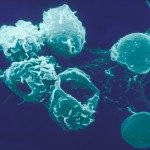Link to Pubmed [PMID] – 23851687
J. Immunol. 2013 Aug;191(4):1716-23
A large fraction of innate NKTγδ T cells uses TCRs composed of a semi-invariant Vδ6.3/6.4-Dδ2-Jδ1 chain together with more diverse Vγ1-Jγ4 chains. To address the role of γδTCR specificity in their generation, we analyzed their development in mice transgenic (Tg) for a Vγ1-Jγ4 chain frequently expressed by NKTγδ cells (Tg-γ) and in mice Tg for the same Vγ1-Jγ4 chain together with a Vδ6BDδ2Jδ1 chain not usually found among NKTγδ cells (Tg-γδ). Surprisingly, both promyelocytic leukemia zinc finger (PLZF)(+) and NK1.1(+) NKTγδ cells were found in the thymus of Tg-γδ albeit at lower numbers than in Tg-γ mice, and virtually all of them expressed the Tg TCR. However, the PLZF(+) subset, but not the NK1.1(+) subset, also expressed an endogenous Vδ6.3/6.4 chain, and its size was severely reduced in TCRδ(-/-) Tg-γδ mice. These results could suggest that the PLZF(+) and the NK1.1(+) subsets are developmentally unrelated. However, PLZF(+) and NK1.1(+) NKTγδ cells express identical Vδ6.3/6.4 chains, and NK1.1(+) cells can be obtained upon intrathymic injection of sorted PLZF(+) cells, thus indicating their developmental relationship. In fact, the NK1.1(+) γδ thymocytes present in Tg-γδ mice correspond to a small subset of NK1.1(+) γδ thymocytes in wild-type animals, which express a more diverse repertoire of TCRs and can be recognized by the expression of the CD62L Ag. Collectively, our data demonstrated that TCR specificity is essential for the development of most NKTγδ T cells and revealed a developmental heterogeneity in γδ T cells expressing the NK1.1 marker.


